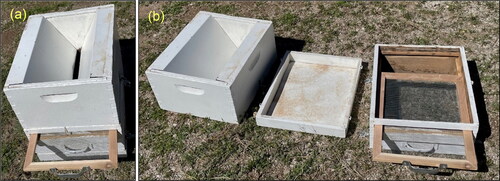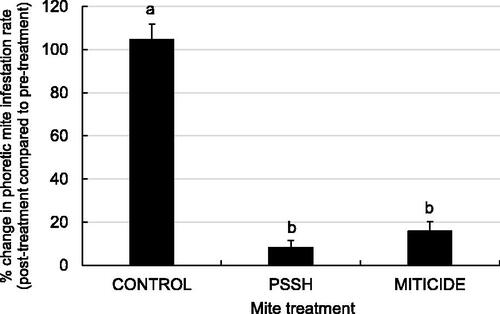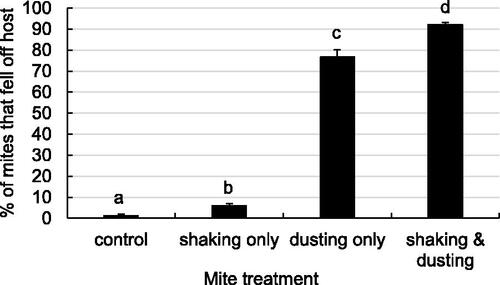Figures & data
Figure 1. (a) Assembled and (b) disassembled powdered sugar shake box used to isolate and treat nest workers against Varroa mite. Box components (top to bottom) include a detachable funnel box to guide bees in, a screened shake box to hold bees, a removable top screen to selectively allow bees in or enclose them, a bottom screen to allow dusted mites to fall out of the shake box, and a detachable bottom catch tray to catch falling mites and excess sugar. Handles allow controlled shaking and rolling of enclosed bees.

Figure 2. Average pre-treatment to post-treatment change in phoretic mite infestation rates (mean ± SE) across three successive mite treatment rounds. Colonies were treated by powdered sugar shake (PSSH), the miticide Apiguard (MITICIDE) or no mite treatment (CONTROL) (n = 6). Colonies were treated three times (every 7 days) to target mites emerging from brood cells over a full mite reproductive cycle. Treatment groups that do not share a superscript differ by DSCF multiple comparisons (ranks, p < 0.05).

Figure 3. Relative sizes of (a) adult worker and (b) brood populations (mean ± SE) in October colonies (four months after initial treatment) compared to pre-treatment values. Adult worker populations were estimated by total mass (colony mass with and without workers) while brood populations were estimated by frame coverage. The October adult and brood populations of each colony are scaled against the initial June populations to provide estimates of relative changes in population size. Colonies were treated by powdered sugar shake (PSSH), the thymol-based miticide Apiguard (MITICIDE) or no mite treatment (CONTROL) (n = 5 (CONTROL or MITICIDE) or 6 (PSSH)). Treatment groups that do not share a superscript differ by DSCF multiple comparisons (ranks, p < 0.05).

Figure 4. Percentage of mites that became separated from their phoretic hosts (mean ± SE) after treatment by different method components of powdered sugar shake treatments. Approximately 300 nest workers were treated in Mason jars by techniques similar to whole colony treatments. Enclosed bees were either shaken, dusted with powdered sugar, treated by both techniques, or left untreated as controls (n = 8). Treatment groups that do not share a superscript differ by DSCF multiple comparisons (ranks; p < 0.05).

Supplemental Material
Download MP4 Video (422.8 MB)Supplemental File 2.xlsx
Download MS Excel (19.8 KB)Data availability statement
All relevant data are within the paper and its Supporting Information files (Supplemental File 2 (data sets)).
